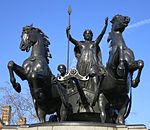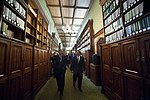2017 Westminster attack

On 22 March 2017, a terrorist attack took place outside the Palace of Westminster in London, seat of the British Parliament. Khalid Masood, a 52-year-old Briton, drove a car into pedestrians on the pavement along the south side of Westminster Bridge and Bridge Street, injuring more than 50 people, four of them fatally. He then crashed the car into the perimeter fence of the palace grounds and ran into New Palace Yard, where he fatally stabbed an unarmed police officer. He was then shot by an armed police officer, and died at the scene. Police treated the attack as "Islamist-related terrorism". Masood said in a final text message that he was waging jihad in revenge for Western military action in Muslim countries in the Middle East. Amaq News Agency, which is linked to Islamic State, said the attacker answered the group's calls to target citizens of states that were fighting against it, though the claim was questioned by the UK police and government. Police have found no link with a terrorist organisation and believe Masood acted alone.
Excerpt from the Wikipedia article 2017 Westminster attack (License: CC BY-SA 3.0, Authors, Images).2017 Westminster attack
Westminster Bridge, London Lambeth
Geographical coordinates (GPS) Address Nearby Places Show on map
Geographical coordinates (GPS)
| Latitude | Longitude |
|---|---|
| N 51.500833333333 ° | E -0.12194444444444 ° |
Address
Westminster Bridge
Westminster Bridge
SW1A 2JH London, Lambeth
England, United Kingdom
Open on Google Maps









